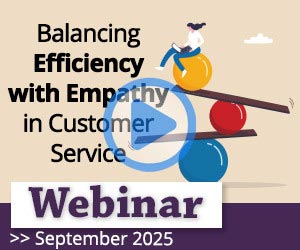Charlie Mitchell explores how contact centres can improve customer conversations through understanding and applying the art of conversation.
The More an Advisor Knows, the More They Will Talk
It is important that every advisor is knowledgeable.
Yet, generally, the more that an advisor knows, the more they will talk, and the less they tend to listen.
The result is that advisors often “bamboozle” customers with too much information which they haven’t asked for. This does not make for good conversations.
To correct this, a good place to start is to listen to the first 20 seconds of a customer conversation in a group coaching session. Consider:
- Does this customer sound like they have time to chat?
- Do they sound as if they are really busy?
Push and Pull Communication
Discuss the signs with advisors, thinking about the customer’s emotional state. Then, introduce the difference between push and pull communication, which is:
- Push communication – The advisor pushes out information to the customer, giving them lots of information and descriptions.
- Pull communication – The advisor asks lots of questions to assess the customer’s needs, letting the customer lead the call a little more.
Push communication works well when dealing with simple, transactional queries, in which advisors can use call control techniques like signposting.
Pull communication is better for complex, emotional contacts – instead of bombarding customers with too much information, which can be unnecessary.
Extrovert advisors often struggle with this, as it is difficult for many people to resist talking about themselves. However, with these emotional contacts, it is best to ask good, simple questions, listen and follow up. Then, be concise and turn it back on the customer.
Ask Good Questions
To create good conversations, it’s easy to think that we must dazzle customers with great anecdotes. But, in reality, the opposite is true.
In complex conversations – where advisors are using pull communication – it is good to listen carefully and then ask:
- Open questions to gather information
- Probing questions to dig further and keep the conversations on topic
- Closed questions to confirm mutual understanding
Asking good questions establishes the advisor as a great communicator. They do not need to lead the conversations. It is better to step back, listen closely and ask pertinent questions, in a friendly tone of voice.
Just be careful to avoid questions that begin with the word “why”. It can make customers feel slightly uneasy, as though they have to justify themselves. That will not improve customer conversations.
To uncover lots more great questioning techniques, read our article: 10 Effective Questioning and Probing Techniques for Customer Service
Show Empathy
Empathy helps us to connect with people, improve interpersonal skills and develop better relationships. It is key to the art of conversation.
However, it is a difficult skill to teach, as it requires the ability to understand and share the feelings of the customer. It is about connecting with the emotions of the other person.
“Look for common ground and mutual understanding,” says Neil Martin, Founder of The First Word. “Try to show the customer that you can – and do – understand them.”
Reflect Back Emotions
Neil continues: “A great way to do this is by reflecting back the emotions and feelings that the customer says in your own words. Not exactly how the customer said it, as that can be mechanical.”
Other great ways to coach contact centre empathy are to encourage advisors to:
- Recall similar experiences that they have had.
- Show interest in the customer, giving them time to talk and think.
- Be empathetic with their colleagues.
Yet, just remember that there is a danger that comes with showing empathy. “Hyper-empathy”, where someone empathizes too much, is a real thing. If the advisor does so, soaking up all of the difficulties of customers, that can get exhausting.
Respect that, offer wellness sessions and check occupancy rates don’t exceed 85%. Otherwise, burnout becomes a real risk.
For more on coaching empathy in the contact centre, read our article: How to Coach Empathy in the Contact Centre – With Three Training Exercises
Active Listening
Active listening is what enables us to show empathy, ask good questions and solve customer queries. It is the opposite of passive listening.
Passive listening occurs too often in contact centres. It is where an advisor is technically hearing what the customer is saying, but they are tuned out.
Why? Well, there are lots of reasons. For example:
- Distractions coming from smartphones, background noise or desktop pop-ups.
- Preoccupations derive from thinking about something else or anxiety. Sometimes one word that the customer says will cause the advisor to drift off.
- Listening to respond, i.e. figuring out what to say next or getting ready to jump in, instead of truly listening. This is a classic human tendency.
- Boredom. The advisor has heard it all before. It’s no longer interesting. The advisor has therefore subconsciously chosen not to take interest in the customer.
Sometimes the customer themselves can be a distraction, as they may have a dull tone of voice, be distracting or maybe just say “umm” a lot.
Engaging in active listening will help advisors to overcome each of these issues, as advisors listen compassionately to meet the customer’s functional and emotional needs. This is through paying close attention to what the customer is saying, not saying and their tone.
“Commit to active listening,” says Neil. “Let’s take off our work hat and stop thinking about how this query is similar to others that we’ve dealt with before, rather than thinking about what the customer is really trying to tell us and what matters to them.”
Other golden pieces of advice for improving active listening in the contact centre include:
- Removing distractions and consciously making listening a real priority.
- Encouraging verbal nods, such as “hmm” or “ah” to help to stay engaged.
- Asking advisors to take notes. This allows them to stay attentive to every detail, without losing the “big picture”, and to ask clarifying questions.
- Building up advisor curiosity, keeping the team open to the fact that others interpret their problems differently.
- Running empathy training to encourage customer compassion.
Discover four fun activities for improving active listening skills in our article: How to Train Active Listening in the Contact Centre – With Four Exercises
Build Up Rapport
Good listening, avoiding assumptions and showing empathy will improve rapport and create better contact centre conversations.
With these foundations, advisors can then use lots of tips and tricks to further develop customer rapport. These may include:
- Opening up the call with a warm, friendly greeting – in an upbeat tone!
- Using the customer’s name, especially when drawing their attention to important points.
- Listening out for shared interests/viewpoints and demonstrating commonality.
- Using positive words and phrases, such as “I know exactly what you mean,” or “I do that too.”
- Telling the customer what you’re doing when searching for information, to avoid dead air time.
Each of these ideas add icing to the conversational cake. However, focus on getting the basics right first. This includes tone of voice…
Don’t stop there! Find more rapport-building ideas in our article: Top Tips for Building Rapport on the Telephone
Tone of Voice
We could break tone of voice down into its fundamental components, such as tone, pacing, volume, emphasis and pauses. Yet it doesn’t need to get that complicated.
It is easy to tell if someone has a problem with tone of voice in quality monitoring sessions.
If an advisor seems to have a tone issue, play them back a call recording and they’ll pick up on that for themselves. When they do, ask the advisor what they think that communicates to the customer.
Such an initiative can be a real eye-opener for advisors, while they can then better appreciate the value of “smiling while dialling” and having good posture while handling customer conversations.
Finally, just make sure that you lead by example on this. Be an energetic leader and ask others for honest opinions about your tone of voice.
4 Barriers to Good Conversations
It’s all been smooth sailing up until now, but it’s important to avoid treacherous waters that can ruin customer conversations. Here are four common examples.
1. Failing to Say Sorry
When experiencing a problem, a fundamental customer need is to hear the word “Sorry.”
Nevertheless, the word is too often either bypassed or customers get given terrible apologies. The classic example is “We apologize for any inconvenience.” Is there a less meaningful statement in the entire English language?
By saying sorry the advisor doesn’t necessarily have to take responsibility for something – if the customer seems to be in the wrong, but they can share an empathetic apology, such as “I’m sorry to hear this.” If the company is in the wrong, then take that responsibility!
The key is to use the word “sorry” to show that the advisor understands how the customer is feeling and accepts the company’s part in it.
Learn how to give authentic apologies to customers in our article: Customer Service Apologies – Keeping Sorry Fresh and Sincere
2. Bypassing
Often two people have different definitions of a word. The words “quality”, “serious” and “help” are all good examples of this.
In the contact centre, the word “soon” is a classic example that can prove to be a real troublemaker.
Without clarifying how soon, the advisor can potentially create a misunderstanding that damages rapport and a customer’s relationship with their brand. This phenomenon is known as “bypassing”.
For instance, if an advisor were to say “That will be done for you soon,” that could cause confusion, as the customer may think “soon” means a day, while the advisor may consider it to mean a week.
Confirming mutual understanding – through closed questions – can ensure that the advisor avoids this conversational pitfall.
3. Generalizing
Sometimes people make generalizations, which maybe be widely spoken, but are simply untrue.
Not only do these generalizations reinforce stereotypes, but they can remove all of the common ground that was established earlier in the conversation.
Even saying something like “Well, everyone is a cynic these days” could negatively impact the conversation if the person on the other end of the line disagrees.
Being specific, to qualify their statements, will help advisors to sidestep these generalizations.
4. Making Assumptions
Advisors can often jump to conclusions based on circumstantial evidence, without gathering the full facts.
This conversational barrier occurs when advisors speculate about what has happened, as if it is a forgone certainty, while it may not be the case.
We see this all the time on social media, especially when it comes to politics, yet it can also be a major problem in the contact centre as advisors are often proven wrong.
Again, this reinforces the value of advisors using active listening and effective questioning.
How to Support the Art of Good Conversation
Good conversations are not only a result of skilled advisors. There are many other ways in which contact centre management can positively influence the art of conversation. These include:
Reviewing Quality Assurance
Too often quality scorecards are focused on processes and outcomes. Contact centres, therefore, have a built-in blind spot as to the language that advisors are using.
When scoring conversations, it is important that contact centres specifically target criteria like:
- Has the advisor offered a genuine apology?
- Has the advisor shown empathy at the beginning of the interaction?
- Has the advisor used effective questioning skills?
This is according to Neil Martin, who says: “Make sure analysts are coached and run calibration sessions. This ensures that everyone knows what the criteria mean.”
Also, it is important that advisors understand the scorecard too and can challenge their results, so they continuously learn – instead of feeling like they have been mistreated.
Build a great contact centre scorecard by following the advice in our article: How to Create a Contact Centre Quality Scorecard – With a Template Example
Building Up a Store of Good Examples
Sharing call recordings and conversation transcripts is a great way to share best practice without telling the advisor “You must do this…” or “You shouldn’t do that.” After all, seeing (and hearing) is believing.
“If you can build up a store of good examples and not-so-good examples to avoid, you help people to tune in to what great conversations actually look like,” says Neil.
Listening to these examples in groups, or reading conversation transcripts, is a great way to open up a discussion around what does and doesn’t work. It also helps to bring the coaching and quality scorecard criteria to life.
Getting Smart About Recruitment
With new homeworking models, contact centres can hire advisors who live right across the country. This greatly opens up the recruitment pool.
With an open recruitment pool, advisors can be hired whose values truly reflect those of the organization and its customers.
“When recruiting agents to handle contacts for BUPA (the health insurance company), we actively targeted people with high emotional intelligence,” says Mark Walton, CEO at Sensée.
“We knew that empathy would be a key skill, so we hired people based on maturity and experience within fields like social care and similar criteria.”
By doing so, Sensée could select advisors who had the best possible chance of creating emotional connections with customers.
Routing Customers to the Right Advisors
There are lots of technologies that are designed to improve conversations in the contact centre. These include:
- A knowledge base – To provide a backup source of information that’s designed to support advisors.
- Speech analytics – To spot coaching needs through analysing transcripts.
- Performance management systems – To automate quality assurance processes, host learning materials and track advisor performance.
- Reporting tools – To benchmark advisor performance and look for signs of improving or worsening performance.
- Gamification – To set advisor goals and create competitions, as well as recognizing and rewarding performance improvements.
However, one that is too frequently overlooked is call routing. This involves matching the right customer to the right advisor. This has numerous benefits in terms of improving contact centre conversations.
Data-directed routing, using artificial intelligence, is the most sophisticated model for this. Skill-based routing, multimodal routing and routing based on business rules are also tactics that can all work well.
Discover lots more clever call routing techniques in our article: The Top 10 Call Routing Strategies
Giving Positive Feedback
Giving feedback is essential in recognizing good performance and motivating advisors to keep improving and having great customer conversations.
“Create a real-time continuous feedback loop that provides the team with meaningful insights into their performance that are not only timely but specific, supportive and direct,” says Mark Walton.
Also, team leaders should be keeping tabs on the mood of the contact centre floor. Of course, this can be tricky in a remote environment, but reporting tools can give indications of when an advisor may need a pick-me-up.
Find out how to give great in-the-moment feedback in our article: 10 Good Feedback Examples to Improve Contact Centre Performance
One Final Point
Following all of this advice is great, but to improve conversations in the contact centre, it is vital to check the team’s “service attitude”.
A contact centre could have all of the policies and procedures in place to be successful, yet advisors may not follow these rules for wonderful conversations.
Why? Because sometimes advisors grow tired of customer conversations and decide “If you’re not going to be nice to me, why should I be nice to you?”
No matter how much you’ve done to improve conversations, this attitude can prevent the delivery of great customer service.
So, don’t let all of your hard work go to waste! Train leaders to monitor attitudes on the contact centre floor and build a positive culture that supports the art of conversation.
For more advice to help improve contact centre conversations, read our articles:
- Positive Language for Customer Service Conversations
- 27 Effective Ways to Build Customer Rapport
- Customer Service Language: Changing the Language of Your Contact Centre
Author: Charlie Mitchell
Reviewed by: Megan Jones
Published On: 21st Jul 2021 - Last modified: 6th Oct 2025
Read more about - Customer Service Strategy, Call Handling, Charlie Mitchell, Communication Skills, Customer Engagement, Customer Service, Editor's Picks, Service Strategy, Soft Skills










































